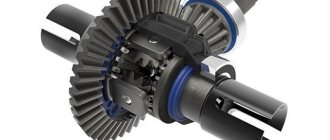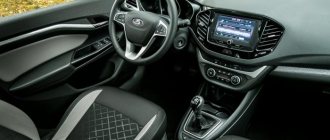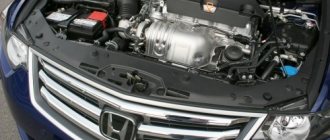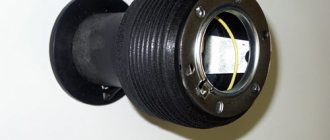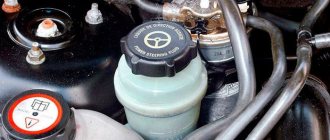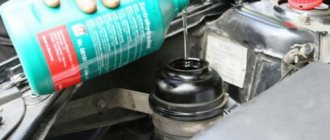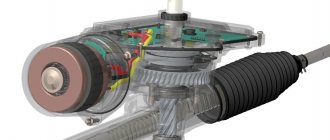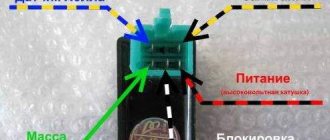Finding the cause of the steering wheel beating, as well as its vibration and shaking, is not difficult if you know in which direction to “dig”. Some faults, literally felt by the driver’s hands, are quite banal, and even novice car enthusiasts can easily identify them. There are, of course, difficult situations. But this applies, as a rule, only to repairing the unit that causes vibration in the steering wheel. Anyone who has at least a general idea of how a car works can find the cause of any complexity.
The purpose of this article is to tell in simple words why the steering wheel of a car can vibrate, beat, shake or wobble in different operating modes. In total, the material examines as many as 20 various defects, the common symptom of which is essentially the same thing. And let not everyone be able to fix the problem found on their own. But coming to the specialists at a service station with a completed task, and not being fooled by “repairing” fictitious faults, is already a victory in our time.
Beating and vibration of the steering wheel in different modes
Finding the cause of the steering wheel beating can be greatly facilitated if you divide all the symptoms into groups depending on the mode of operation of the car. A total of 7 such groups will be considered. Each operating mode of the machine has its own faults.
But keep in mind that some of the defects described here can cause the steering wheel to vibrate in several modes at the same time. That is, for example, the problem is felt both while parked with the engine running and when driving at a certain speed. Other breakdowns are unique in their own way, that is, they manifest themselves only in certain modes. Where this is the case, there are corresponding comments.
So, the steering wheel can vibrate, wobble, beat or shake in the following seven modes of vehicle operation:
- Steering wheel vibrations when parked at idle.
- Steering wheel shakes when accelerating.
- Steering wheel vibrations when driving at low speed in a straight line.
- Steering wheel vibrations when driving at high speeds in a straight line.
- The steering wheel wobbles and wobbles when cornering.
- Steering wheel vibrations when braking.
- Vibrations and beating of the steering wheel when driving on a bad road.
We emphasize that even if your problem manifests itself only in one mode, you should not skip the possible causes presented from other groups. It is quite possible that the solution will be found there.
Dangerous vibration: loose wheel bolts/nuts
Another easily removable and no less easily diagnosed cause of steering wheel wobble and car vibration is simply loose bolts or nuts securing a wheel (or several wheels at once, which is less common). This reason for the beating is simple, but the most dangerous - if you do not detect the problem in time and the wheel completely flies away from the car, then this can end very disastrously both for you and for surrounding road users. However, repairs in this case can also turn out to be expensive if the cause of the vibration is not noticed in time - you will have to change the discs and, possibly, the brake disc or part of the hub, since the wheel will rub with enormous force against loose bolts or cotter pins, which will lead to severe deformation of these bolts or cotter pins, as well as the mounting holes in the disk.
The symptoms of vibration for this reason are similar to those as if the beating was due to deformed disks or tires, with the difference that it can begin at very low speeds - including at the very beginning of movement, and the vibration itself may not be with a clearly monitored cyclicity and is not always observed at the same speeds.
Just tighten all the bolts/nuts of your car's wheels to make sure that this is not the cause.
Idle parking
Many people mistakenly believe that the causes of steering wheel vibration at idle are harmless and do not require prompt elimination. The car is standing still - what could happen? However, some of the defects discussed below are quite dangerous, so they may well make themselves felt not only while parked, but also when driving at a decent speed. Therefore, you should not neglect even this kind of vibration of the steering wheel.
Reason #1. Worn or loose engine mounts
In the vast majority of cases, this reason provokes vibrations not only in the steering wheel, but is also transmitted through the body. In particular, poorly attached plastic parts of the interior, dashboard, and so on can make annoying noise due to shaking. In this case, vibrations on the steering wheel can be felt not only when parked with the engine running, but also in absolutely any other modes listed in the list above.
Identifying a defect of this kind is quite simple. To do this, just open the hood and look at the engine idling. Ideally, the power unit should not twitch even when operating at low speeds. Moreover, regardless of the year of manufacture of your car. On a securely mounted and balanced motor, you can place a coin on its edge and it will not fall.
If the engine “sausages”, the first thing you should pay attention to is the so-called cushions through which it is attached to the body or subframe of the car. The task of these supports is precisely to dampen the smallest vibrations. But, if they are worn out, or the fasteners that secure them are loosened, the shaking will periodically intensify due to the resonating effect. Accordingly, not only the steering wheel, but also the entire car will vibrate, whether when parked or when driving.
Unfortunately, simply tightening the fasteners in such cases rarely helps. More often you have to change those same shock-absorbing pillows. They are relatively inexpensive, but the procedure for replacing them can discourage beginners from rolling up their sleeves with its apparent complexity.
Reason #2. Triggering engine
A throttled engine is one in which not all cylinders operate evenly and without interruption. If one (or more) of them has misfires, interruptions in the fuel supply (in diesel engines) or the air-fuel mixture (in gasoline engines), compression problems and other problems, the engine will misfire. Physically, this defect manifests itself in the form of vibration, which is caused by a violation of weight and inertial balance. Accordingly, vibrations of the steering wheel are accompanied in such cases by shaking of the entire car, but they also differ from the previous cause by a decrease in dynamics.
It is not always easy for beginners to identify a stalling motor, much less find the cause of the problem. As a rule, in addition to the vibration of the steering wheel in such a breakdown, symptoms such as unstable operation of the engine, “dullness” of the car during acceleration, and others are added. Well, finding the reason why the engine is tripping is a whole epic that requires a separate article.
Reason #3. Idle speed too low
In this case, everything is extremely simple. If the crankshaft rotation speed at idle is insufficient, the engine begins to operate unstably. The defect appears both constantly and under certain conditions. For example, idle speed may drop below normal after turning on the heater, headlights, or any other powerful load. In a working car, this whole thing should be compensated, and as a result the idle is maintained at the desired level.
Similar to the previous problem, there is no particular point in describing the solution to this one within a couple of paragraphs. The topic is vast, and its development depends on a number of factors. Only one thing remains clear - low or periodically falling idle speeds may well cause vibration or systematic shaking of the steering wheel. It is quite logical and natural that the problem disappears when the engine runs at medium and high speeds.
Reason #4. Steering rack drive shaft wear
This part is designed to convert the torque created by the efforts of the driver's hands into forward movement of the steering rack. When this unit is broken, engine vibrations through it may well be transmitted to the steering wheel, even if the car is just standing still. Also, the source of nasty shaking on the steering wheel in this case may be incorrect operation of the hydraulic booster.
Diagnosing this breakdown in a garage environment is very difficult and slow. So, if you are a novice car enthusiast (and this is exactly what this material is designed for), or if you don’t fundamentally tinker with your car with your own hands, contact a specialist with a ready-made task.
Cause: Steering rack wear
Perhaps the most unpleasant problem that causes the steering wheel to shake in the cabin is wear on the steering rack. On the VAZ 21099 this part can be called reliable. But everything has its own service life. And if we take into account that long driving with poor balancing, inattention to ball and rods necessarily lead to increased wear of the steering rack, then the questions disappear by themselves.
How to fix
Sometimes you can get away with minor intervention by simply eliminating the gaps between the rack and the rods (which weaken with use) or replacing the rubber-metal parts of the tips.
In particularly severe cases, you will have to contact service and install a new rail.
Overclocking
Vibrations in the steering wheel are extremely rare exclusively during acceleration. As a rule, if they exist, they are duplicated in other driving modes. Again, the 4 reasons already discussed for the steering wheel beating at idle may well appear during acceleration. But, despite this, there are still some defects that can claim to be unique causes of vibration during acceleration. We will consider them first, and the rest - to the heap, as they say.
Reason #5. Unbalanced wheels
Probably the most common cause of steering wheel beating during acceleration is wheel imbalance. In its own way, this is a unique defect that rarely appears in any other mode of vehicle movement. Including, as a rule, steering wheel vibrations gradually or suddenly disappear as soon as a decent speed is gained, or it decreases. We emphasize - only, as a rule, but not in 100% of cases. Sometimes unbalanced wheels can be felt on the steering wheel either during acceleration, at speed, or when braking.
What wheels are called unbalanced? These are considered to be those wheels whose weight is unevenly distributed around the entire circumference. That is, roughly speaking, on one side the wheel is a little heavier than at other points. And since these car parts rotate, they are largely subject to the influence of centrifugal force. And when the wheels are not balanced in weight, different centrifugal forces act on different points on them. Hence the vibrations on the steering wheel.
The first thing you can do is inspect the rims for any stuck dirt or snow if it's winter outside. Despite the apparent innocence, even small accumulations of dirt, snow or ice lead to a significant imbalance in weight. Accordingly, cleaning and washing with further regular maintenance completely solves this problem.
If the rims are clean, the next step is to inspect the tire treads. Small pebbles often get stuck in them, which, despite their miniscule weight, in sufficient quantities can become a very real cause of vibration on the steering wheel. Winter tires especially “like” to accumulate such things.
And one last thing. To prevent the wheels of the car from causing vibration in the steering wheel during acceleration and movement due to imbalance, they must be balanced in a timely manner at the appropriate services. This service is cheap, and there is no point in repeating it often. As a rule, seasonal balancing is enough, when winter tires are changed to summer tires, and vice versa. Here it is quite reasonable to make a remark that applies to fans of so-called all-season tires, which are used on a car for several years. Naturally, no one usually does any balancing in such cases twice a year. Meanwhile, she is so needed.
Reason #6. Loose hub bolts (nuts)
Despite the fact that this reason may seem rather ridiculous to many, it is not so rare. The fasteners that secure the wheel rims to the hubs can easily become loose, even if they are tightened to the correct torque. To do this, it is enough to simply “successfully” drive into a hole of medium depth. Well, for this to happen if the hub bolts were not tightened to begin with, we will remain silent at all.
This, by the way, is very common among novice car enthusiasts who change a broken tire on their own for the first time. They tighten the bolts (or nuts) while the car is on the jack, and after lowering it, they either forget to tighten it or are simply distracted by something.
The result of all this is the same - first, vibrations are felt on the steering wheel, or rather, its systematic and ugly wobbling to the sides. Well, then, if appropriate measures have not been taken, you can be left without one wheel on the road while driving. There are plenty of examples from life - look on YouTube. But first, check that the bolts on your wheels are tight.
Reason #7. Worn steering rack
This reason is no longer as unique as the previous one. Steering rack wear in the form of vibration, wobbling or beating of the steering wheel can be felt both when accelerating the car and during measured movement. But, nevertheless, more often this “illness” manifests itself precisely during acceleration (as well as during maneuvering).
For novice car enthusiasts, trying to identify wear on the steering rack is practically useless. It is much better to address this possible problem to someone who knows how to do it. In any case, if the reason turns out to be in the steering rack, you cannot avoid replacing a rather expensive part. And this must be done without much delay, since the dead rack will soon “drag” other parts of the steering mechanism with it. In the end, driving such a car is unsafe for both you and other road users (in fact, like most other causes of steering wheel vibration).
Reason #8. Worn tie rod ends
Steering ends are parts of the steering mechanism, through which the rack is connected to the hubs of the front wheels through rods. Extremely, it must be said, elements subject to frequent wear. The only good thing is their cost. Of course, the cost of replacing them is a little upsetting, as well as the need to perform wheel alignment adjustments after this procedure, which also costs money.
However, loose steering ends are a guaranteed vibration on the steering wheel. This defect often manifests itself in the form of so-called spontaneous wobbling of the steering wheel to the sides. Especially when the car accelerates or moves at low speed. Also, the wear of the steering tips makes itself felt on the steering wheel when the car gets into a rut on the road.
Diagnosing tie rod ends is easy even for a novice car enthusiast. It is better, of course, to do this with an assistant. There are only two diagnostic options. The first is to rotate the steering wheel back and forth with one, while the second is to look from below at the behavior of the parts. Loose tips are usually visible immediately. And the diagnosis can be confirmed using the force applied to the steering rods in the directions of their movements, that is, towards the corresponding wheel and back.
There is, in fact, nothing to repair here. Only complete replacement of parts.
Reason #9. Wear and other problems with wheel bearings
The name of the part speaks for itself - the wheels on the hubs rotate on these bearings. If they wear out, vibrations on the steering wheel appear, again, more often when the car accelerates. Also, heavily worn wheel bearings can literally be felt by the vestibular apparatus during maneuvering. Anyone who has had it will understand what we're talking about.
Checking wheel bearings for wear is quite simple and without a specialist, which cannot be said about replacing them. Diagnostics consists of shaking the wheel hanging on a jack. It is better to stagger from under the car while in the inspection hole. This way it will be possible to more accurately see where there is play - in the hub, or somewhere on the elements of the steering mechanism or suspension.
It is clear that there is nothing to repair here. Just buy new bearings and install them instead of the dead ones. Let us repeat that this procedure is quite complicated, and it is better not to undertake it without prior preparation.
Steering mechanism
The main elements of the VAZ 2109 steering wheel control are:
- Steering mechanism. It has a rack and pinion transmission, due to which the force is increased and transmitted to the steering drive from the steering wheel of the car.
- Drive wheels.
Steering of a VAZ 2109 car
- 1 – steering wheel.
- 2 – shaft with drive gear.
- 3 – drive rack.
- 4 – traction.
- 5 – levers through which the wheels are turned.
- 6 – drive wheels.
While driving, turning the steering wheel by the driver causes the gear to rotate. This element moves the steering rack to one side or the other. The force applied to the steering wheel is transmitted to the rods: left and right. By means of levers that rotate the telescopic struts located on the wheel suspensions, the latter rotate.
Driving in a straight line at low speeds
There are also reasons for steering wheel beating that manifest themselves exclusively when driving at low and medium speeds. Again, we should not exclude the defects already discussed, just like those described below in other sections.
Reason #10. Disc deformation
A fairly common cause of steering wheel wobble at low and medium speeds. Most likely, even novice drivers do not need to explain in detail what deformation is and where it comes from. With our famous roads this is almost a “number uno” problem.
Finding the cause is simple and involves a visual inspection of the wheel rims. Particular attention is paid to those places where the tire “sits” on the rim. This place is called the rim of the wheel, and it is this place that is the first to suffer from hitting potholes and other road irregularities. We must also not forget that a wheel rim, no matter how strange it may sound, has two sides - outer and inner. So, the inner side is often forgotten, never looking at it. Meanwhile, according to the law of meanness, deformations, which are a common cause of steering wheel beating, are located exactly there.
Repair here is simple and relatively inexpensive, if the disk is not in the trash. A common procedure called rolling returns the wheels to a perfect circle shape, and the vibrations may well disappear completely. Of course, it will be a little more difficult and more expensive for those who have cast or forged wheels. Even if these are subject to rolling, it is done with difficulty, for which specialists want appropriate payment. There are never any problems with steel discs, unless they burst.
When preparing this material, information was found on the Internet that stamped steel disks are sometimes even leveled to perfection using a sledgehammer. Who knows, maybe we have such daredevil blacksmiths, but in the (subjective) opinion of the author, trusting such craftsmen with the wheels of your car is a bad idea...
Reason #11. Unadjusted camber and toe
Here, too, apparently, nothing special needs to be explained. Suffice it to say that wheels “looking” in different directions is a sure cause of steering wheel vibration. The problem appears more often during acceleration and when driving at low speeds. When a significant speed is reached, it usually disappears temporarily.
Diagnosis is simple if the case is very advanced. Crooked wheels are visible to the naked eye. In any case, even if the deviation is not visible without equipment, it will not be possible to adjust the camber and toe without them. It doesn't work by eye here. Therefore, if you have any suspicions about this, or simply haven’t had your camber and toe-in adjustments done for a long time, contact the appropriate service. The procedure is not so expensive that you would waste money on performing it at least twice a year.
After any repairs related to the suspension, steering, as well as replacing rims and even tires, camber and toe adjustment is simply a must, regardless of the last time you did it. Even the day before yesterday...
Steering wheel runout on a VAZ 2109: how to remove it
Steering wheel beating on a VAZ 2109 car
While the car is moving on the road, the driver often needs to change the direction of movement, increase or decrease the speed, and stop. These are designed to perform auto control mechanisms. These include: steering and brake systems. In the direction specified by the driver, the movement of the car is ensured by the steering. An unpleasant phenomenon on a VAZ 2109 car is steering wheel beating. The article suggests familiarizing yourself with the main causes and ways to eliminate this phenomenon with your own hands.
Driving in a straight line at high speeds
Quite often, those causes of beating in the steering wheel that do not appear during acceleration or during measured movement create fear on the highway. When the speed exceeds 100-120 km/h. Moreover, on a seemingly absolutely flat road. There are only two unique reasons here. Let's talk about them a little. But let’s also not forget about what has already been said, since crooked wheels, defects in the steering mechanism and chassis can also make themselves felt only at a respectable speed.
Reason #12. Cones
They're hernias. These are fairly common tire defects that appear due to the destruction of the stiffening frame - or the cord made of wire (threads). When the cord breaks in a certain place, due to decent pressure in this place, a lump comes out. Firstly, it leads to imbalance. Secondly, the hernia may be right on the contact patch of the tire with the road, causing the car to seem to bounce slightly with each revolution of the damaged wheel. When the speed is high, all this turns into small, but rather unpleasant vibrations on the steering wheel.
By the way, many car enthusiasts note that by the speed of the car it is sometimes possible to determine on which axis there is a defect that causes the steering wheel to wobble. It is believed that if vibrations occur at speeds of 90-100 km/h, then the problem should be looked for, first of all, on the wheels of the front axle. Accordingly, if the steering wheel shakes after the speedometer needle goes beyond 110-120 km/h and beyond, the rear axle is “to blame.” Unfortunately, in practice it cannot be proven that this is 100% true, and it always repeats itself in the same way. But it still doesn’t hurt to keep this information in mind. Who knows, maybe this will be the case for you, and you will quickly find the cause of the steering wheel beating...
Reason #13. Different tire pressures
This may also well lead to unpleasant vibrations in the steering wheel, but only under one condition. It lies in the fact that the pressure should be different in the wheels on the same axle, and the difference should be quite significant. The physics of vibrations for this reason is quite simple. An empty wheel has a smaller diameter and, accordingly, a smaller circumference. Because of this, it periodically pulls to the side, which at low speeds is felt in the form of excess load on the steering wheel, and at a decent speed - in the form of vibrations and rather terrible wobbles.
The solution to the problem is simple and obvious. The tire pressure needs to be equalized, and this must be done, moreover, regularly. Especially if the tires are not new, or you often drive on terrible roads, which is generally the norm for some domestic car owners.
Ways to solve the problem
Whatever the reasons for the steering wheel beating, it is necessary to carry out high-quality diagnostics and eliminate the problems. This will make it possible to avoid expensive repairs, and most importantly, prevent accidents!
If the steering wheel shakes at low speed, proceed as follows:
- check the cleanliness of the wheel rims;
- check the balancing and fastening of bolts on the wheels;
- test discs for deformation;
- check the quality of rubber;
- diagnose the suspension;
- examine brake discs and drums;
- check the engine mounting;
- try the quality of the drive shaft.
Wheel rims are easier and faster to clean at a car wash. A stream of water will remove accumulated dirt. Hit the disc with some object, reducing the amplitude of vibrations of the steering wheel, in order to safely drive to the car wash or service station.
Have your balancing done at a tire shop. Balance all 4 wheels, especially if the steering wheel shakes at low speeds. At the same time, eliminate the deformation of the wheel rims and give them their initial shape on a straightening machine.
Replace defective tires. It will not be possible to restore it - you will have to buy new tires and mount them according to the canons of proper balancing.
Steering wheel wobble at speed due to a faulty suspension or steering mechanism is “treated” by disassembling the chassis, inspecting the parts and fixing the problem. More often than others, grenades (CV joints), rubber-metal joints, and steering bushings break.
The beating that occurs during braking can be eliminated at a service station. The machine grinds and restores the surface of the brake discs if the degree of wear is low.
It is better not to fix steering wheel wobble at speed yourself. Only car services will accurately determine the cause of the breakdown and eliminate it. Most workshops work with specific brands of cars; they have a better understanding of the specifics of the models, know the characteristic “sores” and are able to quickly recognize them.
Unfortunately, most car owners believe that car vibration and steering wheel wobble necessarily mean that they simply need to balance their car's wheels. But this is not always the case, although improper wheel balancing is one of the most common causes of such vibration on the steering wheel or the entire car.
The problem is that vibration of the steering wheel (as well as the entire car) is not only one of the most common, but also one of the most annoying problems. Moreover, it often creeps up on us gradually and unnoticed - until one fine day we begin to understand that the steering wheel is already hitting quite hard at speed or when braking, and it reverberates throughout the whole car, but we understand that we are already accustomed to it and That’s why we don’t rush to a specialized service or tire shop to fix the problem.
But, most likely, at this time you asked yourself the question, what does it mean if your car vibrates, what are the reasons for the steering wheel beating? And, despite the fact that there are a number of reasons for this, it will most likely be possible to sort out the problem without resorting to large expenditures of money. However, having established the cause of the beating, you may have to spend money on repairs and eliminating the causes of such vibration. We must also understand that in the long term this will give us significant savings due to the failure of certain steering or suspension elements.
Maneuvering
There are only three reasons why the steering wheel vibrates during maneuvering, that is, during cornering or when aggressively changing from lane to lane. However, it is possible that the problem is what has already been discussed above. Although in such situations, steering wheel beating is observed not only during maneuvering.
Reason #14. Worn CV joint
CV joints are constant velocity joints. They are designed to transmit torque from a gearbox or gearbox to the drive wheels. They are designed quite cleverly and, since they are directly attached to at least a pair of wheels on the same axle, they are quite capable of causing vibration in the steering wheel.
As a rule, if the car is front-wheel drive, then wear on the CV joint can be heard when the car turns or turns with the steering wheel turned completely. People say that they crunch when doing so. If the car is rear-wheel drive, then a broken CV joint should probably not be the cause of steering wheel vibration. Such problems manifest themselves in a different way - the same crunching, knocking, sometimes metallic grinding, as well as twitching of the entire car due to the fact that one of the CV joints is already jammed.
Reason #15. Steering gear bearing wear
These bearings are located in the gearbox, through which the force of the steering wheel is transmitted further along the mechanism to the front wheels. When they wear out, not only vibrations of the steering wheel appear, but also its noticeable play. Repairs, unfortunately, are complex and not always inexpensive. But these same bearings break quite quickly due to bad roads. In some cars this is a sore spot, as their owners say.
Reason #16. Worn steering column driveshaft
Connects the steering wheel to the gearbox and other parts of the steering mechanism. The bushings in it wear out, which are often made of plastic, and very often of extremely poor quality. The steering column cardan itself is also not hanging in the air, and therefore the support bushings or bearings can also wear out, which will cause annoying vibrations in the steering wheel. It is not difficult to identify this breakdown, since the steering wheel play is also added to the vibrations.
Reason #17. Wear of anti-roll bar bushings
Such a breakdown leads to much more serious problems than simple vibrations of the steering wheel when turning. Fortunately, this part is easy to diagnose and repair. Roughly speaking, this is, in a special way, a curved iron bar fixed at four points. At these very points there are rubber bushings that need to be inspected for wear.
Diagnostics and standard causes of vibrations
VAZ 2110 vibration on the steering wheel
There may be several reasons why vibrations are observed on the steering wheel of a VAZ 2110 car. In many cases, a superficial diagnosis will not provide accurate answers, and only a competent, thorough examination will help determine an accurate diagnosis.
Brake pads
As a rule, new motorists who understand little about cars naively believe that shaking and vibration are the result of worn brake pads. Having installed new brake pads, motorists begin to understand that the reasons lie much deeper. Although, if this “disease” has not gone too far, then changing the pads also helps, but for a while. And for the most part, replacing pads with new ones is a waste of time and effort.
Discs
As for the so-called “garage” specialists, they will all say the same thing - vibrations are associated with brake discs that need to be replaced with new ones. And it is imperative to install imported brake discs, since domestic ones do not cope well with their function. What's true is true. The runout of domestic brake discs installed on a car is much greater than even that of old discs installed on an assembly line. In addition, the metal of our discs is often “raw,” so to speak, that is, it is easily affected by the brake pads and wears off.
Note. Installing new brake discs does not completely guarantee that vibrations will disappear. The fact is that the reason may lie even deeper, and changing disks will only give half the effect.
Grooving brake discs
Grooving brake discs
Usually, when a car runs more than 50 thousand km, complaints about steering wheel shaking increase. The standard diagnostic option in service centers is as follows:
- The chassis of the car is carefully checked;
- The vehicle controls are subject to diagnostics;
- The left steering tip is often replaced;
- Wheels are being balanced;
- Brake discs are either replaced with new ones or sharpened.
The question arises: why buy new brake discs, especially ventilated ones (they are not cheap), if you can simply grind them, which gives excellent results.
Attention! It is noteworthy that sharpening brake discs is not so easy. This requires the skills of a highly qualified turner, who can identify by eye the excess part of the working surfaces, which he can successfully grind off. After this, the surfaces may remain rough, but there is no need to worry about this.
Attention! The minimum permissible thickness of a ventilated disc for a VAZ 2110 is 17.8 mm, and a non-ventilated one is 10.8 mm.
Non-standard reasons
It’s interesting, but it also happens that after sharpening and installing the discs, the vibrations on the steering wheel do not disappear. In this case, an unconventional method can help - turning the hub itself on a lathe, which reduces runout.
Algorithm for grooving the hub
- A special device is attached rigidly and at the desired angle (necessarily strictly perpendicular to the plane of rotation);
- Powerful supports are placed under the car;
- The jack is removed, and the brake caliper is tied firmly to the shock absorber strut.
Note. You need to tie the brake caliper with wire and away from the lathe.
- We start the engine;
- We turn on fourth gear;
- We connect the “machine”.
Note. The chips should be thinly wound around the cutter. After one full pass, the remaining portion will be visibly visible on the hub. After the next few visits, this very “bald patch” will completely disappear.
- The hub is ground to zero.
The grenade fell apart
On a VAZ 2110, the causes of vibration in the steering wheel may be associated with a grenade, although some would-be masters deny this. Features of steering wheel vibration when a grenade is scattered:
- When accelerating, vibrations are clearly felt;
- You feel them and disappear when you coast;
- In the early stages, steering wheel vibration can be felt at speeds of 60-80 km/h;
- At low speeds vibrations are not felt;
- The car may run off the road in the later stages of this disease, especially at speeds above 100 km/h;
- In addition to the vibrations, you also feel a terrible knocking sound, and when you release the gas pedal, the vibration immediately disappears;
- Vibrations can clearly increase in proportion to the number of people in the cabin (the more people there are, the stronger the vibration);
- A strong frontal wind can also cause an increase in vibrations.
If you observe the above symptoms, you need to inspect the grenade. It is noteworthy that a CV joint defect may not be immediately noticed. You'll have to tinker a little, take the shafts with grenades in your hands and twist them, changing the angle.
Wheel balancing is the most common cause of vibration in the steering wheel.
Steering wheel VAZ 2110
As you know, balancing the wheels of a car plays a vital role in driving a vehicle. It can be damaged by any little thing or foreign objects that get into the wheel tread.
Note. Experts advise checking the balancing every 5 thousand km of the car.
It is worth noting that there are no perfectly balanced wheels. It is customary to recognize each wheel as having its own heavy section, which, when spinning and gaining speed, prevents the car from driving normally. If the balancing is incorrect, the car begins to bounce and sway on the road, and vibrations are felt in the steering wheel.
Steering wheel vibration due to improper wheel balancing
Symptoms of vibration on the steering wheel due to improper balancing
- Vibrations usually appear when driving in a straight line at speeds above 100 km/h;
- Vibrations can also be felt when turning the steering wheel;
- They are also noticeable when accelerating or braking the vehicle;
- The steering wheel also vibrates when the car is idling.
Balancing should always be carried out in services where there is special equipment for this. The usual procedure is as follows:
- The wheel is washed and cleaned;
- Then they are installed on a special balancing stand;
- After this, the location of installing the additional load on the wheel disk is determined;
- The wheel is then mounted on a special type of adapter;
- Balancing is carried out again, since the fixing cone of the wheel during operation could be subjected to various mechanical damages.
As for the final balancing, it can be carried out without removing the wheels:
- The vehicle is supported using a jack;
- The wheels are then accelerated to the equivalent of driving at 120 km/h.
Final balancing is considered the most accurate and is usually carried out at the end. Of course, you won’t be able to do the balancing yourself, but you can still determine the cause of the steering wheel vibrations yourself. It will also be useful to view many photos, including those carried out here, and videos. Detailed instructions that provide ways to replace various parts, such as discs or pads, will also be very relevant. In any case, the price of the repair that you can do yourself will be several times lower than the operation that will be done at a service station.
Braking
It is quite natural that many of the already discussed causes of steering wheel vibration may well be duplicated during braking. But there are also those who manifest themselves precisely in this mode. This property makes them unique in their own way, and therefore easy to diagnose.
Reason #18. Warped brake discs or drums
Everything is simple here. When braking, the brake pads do not slide on a flat surface, which is why the steering wheel wobbles. As a rule, the cause is accompanied by vibration of the brake pedal, felt by the foot. Warped discs are often visible to the naked eye, although sometimes the problem is only revealed when examined by a specialist.
Reason #19. Uneven wear on brake discs or drums
The same. Vibrations are present not only in the steering wheel, but also in the brake pedal. The development is also clearly visible, and therefore diagnosing this problem does not require special knowledge and experience. The same, again, cannot be said about repairs.
Out of balance due to mud or snow
One of the most likely reasons is that the disk is simply clogged with dirt or snow - in this case, the beating appears temporarily, it can stop literally immediately after gaining speed and does not appear again or after several minutes of driving. Determining the presence of dirt is easy in the case of alloy wheels and quite difficult in the case of steel wheels (which, as a rule, have rather small ventilation holes, and even decorative caps can interfere with visibility) - dirt is usually concentrated on the inside of the disk.
Driving on a bad road
Our long list of possible causes of steering wheel wobble is completed by a defect that manifests itself mainly when driving on a bad road. This also includes driving on cobblestones, which may well be quite good.
Reason #20. Wear of ball joints
Ball joints are the units on which the front wheels seem to rest. In our time, they wear out quite quickly and provoke vibrations on the steering wheel, as a rule, during straight-line movement over holes, potholes, speed bumps, and so on. Checking ball joints is quite difficult. To do this, you need to hang the car on a jack or lift, and then use some kind of lever to influence this unit. Even fairly significant wear cannot be detected by simply tugging with the naked hand.
5 The steering wheel jerks on uneven roads and turns - the main reasons
It is not uncommon for the steering wheel or the entire car to vibrate when the car enters a turn. This usually indicates a failure of CV joints (constant velocity joints) or silent blocks. In such cases, vibrations are usually accompanied by a characteristic crackling and crunching sound coming from the wheels. The occurrence of such problems should be the reason for contacting a car service center, where the condition of the wheel bearings and other elements of the vehicle will be checked during repairs. If such malfunctions are not corrected in a timely manner, the likelihood of failure of parts of the vehicle's chassis system will increase.
The first evidence of impending problems in the chassis is the cracking of the anthers. A characteristic sound can be heard if cracks appear on the anthers, as well as due to sand or dirt getting into the lubricant. If the boot is simply clogged, it needs to be cleaned and lubricated. If small cracks appear, the part should be replaced. Steering wheel vibration can also occur when driving on uneven roads. Such problems indicate possible damage to the steering rack. The element of the steering rack that is most susceptible to damage is the bushing, which is why it is the first thing to check.
Another reason for such problems may be the poor condition of the shock absorbers. A faulty shock absorber loses its ability to soften shocks and vibrations transmitted from the wheels to the steering mechanism. If the steering rack is in order, then the shock absorbers of your car need repair or replacement.
There are different reasons for the steering wheel beating, but your actions when such a problem occurs should be the same in any case. You should have your car diagnosed as soon as possible to prevent damage to important parts and accidents on the roads.
How to identify the source of vibration
Determining the source of vibration is a very difficult issue. To begin with, a car enthusiast must understand when vibration occurs - in a moving or stationary car.
In addition, it is necessary to analyze when the vibration appeared. Perhaps repair work was only recently carried out at a service station, or this phenomenon was noticeable from the very first days of purchasing the car.
The first thing you should pay attention to is engine performance. Vibration in the cabin is often felt precisely because of incorrect settings of the “heart” of the car.
Now reading Knock when turning the steering wheel, causes and ways to eliminate them
The generator overcharges the battery, causes and solutions
To analyze this moment, it is necessary to observe the operation of the engine at idle - how “smoothly” it runs, whether there are periodic “fall asleep” and “bursts”.
To make the check more effective, you can call a friend to help you. In this case, one will observe the vibration in the cabin, and the second will carefully inspect the engine compartment.
Worn suspension
Heavily worn chassis components can cause vibration in the steering wheel. Suspension affects the vehicle's contact with the road. If there is play in the chassis, then this is the cause of the imbalance during rotation. But suspension play is only a “catalyst” for wheel vibration. It in itself cannot serve as the main reason for steering wheel vibration.
Speeds of 100-120 (VAZ - 2108 is no exception) can demonstrate it to you when the car has a faulty steering mechanism. It is necessary to eliminate these breakdowns first. It may be dangerous. However, problems should be diagnosed last, if all other components are in perfect order.
How can you solve the problem?
Some will take their favorite car to a service station. However, this should only be done when there is a reliable specialist who knows his job well. Otherwise, there is simply no guarantee that the source of vibration will be detected and the problem will be solved. Even in the event of such troubles (and they occur very often), repair specialists can charge a high price for the work. The driver may also pay for unnecessary operations. For example, a service station offers to replace the entire steering mechanism completely. Doing this is much easier than figuring out why the steering wheel shakes at low speed. The owner should be well aware of the reasons for this behavior - then he will not need the help of the service. You can almost always fix the problem yourself.
